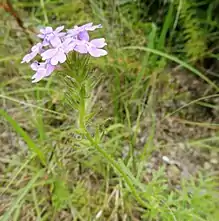| Glandularia bipinnatifida | |
|---|---|
 | |
| Scientific classification | |
| Kingdom: | Plantae |
| Clade: | Tracheophytes |
| Clade: | Angiosperms |
| Clade: | Eudicots |
| Clade: | Asterids |
| Order: | Lamiales |
| Family: | Verbenaceae |
| Genus: | Glandularia |
| Species: | G. bipinnatifida |
| Binomial name | |
| Glandularia bipinnatifida (Nutt.) Nutt. | |
| Synonyms | |
| |
Glandularia bipinnatifida, commonly called Dakota mock vervain,[1] prairie verbena, and Moradilla, among others,[2] is a species of flowering plant in the verbena family (Verbenaceae).
It is native to North America, where its natural range extends from the United States south to Nicaragua.[3] In the United States, it is found primarily in the Great Plains and in the Blackland Prairies of the Southeast.[4] Elsewhere in North America, it is occasionally found as a non-persisting waif.[5] Its natural habitat is in open grassy areas, including prairies. It can be found in both high-quality natural communities and in disturbed areas.[5][6]
Glandularia bipinnatifida is an herbaceous or semi-woody perennial.[7] It produces pink or purple flowers primarily in the spring, but can bloom anytime throughout the growing season.[6] Its leaves are finely dissected, into segments that are 1–4 mm wide. It can be distinguished from the similar-looking Glandularia pulchella by its long flower bracts, and wider leaf segments.[5]
References
- ↑ USDA, NRCS (n.d.). "Glandularia bipinnatifida". The PLANTS Database (plants.usda.gov). Greensboro, North Carolina: National Plant Data Team. Retrieved 8 February 2018.
- ↑ "Glandularia bipinnatifida". Lady Bird Johnson Wildlife Center. The University of Texas at Austin. Retrieved 4 June 2021.
- ↑ Ibid.
- ↑ "Glandularia bipinnatifida". County-level distribution map from the North American Plant Atlas (NAPA). Biota of North America Program (BONAP). 2014. Retrieved 8 February 2018.
- 1 2 3 Alan Weakley (2015). "Flora of the Southern and Mid-Atlantic States".
- 1 2 Diggs, George; Lipscomb, Barney; O'Kennon, Robert (1999). Flora of North Central Texas. Botanical Research Institute of Texas. p. 1050.
- ↑ "Glandularia bipinnatifida". Lady Bird Johnson Wildlife Center. Retrieved 4 June 2021.